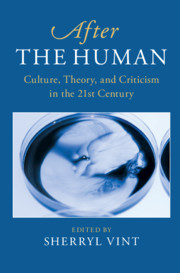Book contents
- After the Human
- After Series
- After the Human
- Copyright page
- Contents
- Contributors
- Acknowledgments
- Introduction
- Part I After Humanism
- Part II New Objects of Enquiry
- Chapter 6 Machines, AIs, Cyborgs, Systems
- Chapter 7 Animals
- Chapter 8 Life “Itself”
- Chapter 9 The Anthropocene
- Chapter 10 The Inorganic
- Part III Posthumanities
- Collective Works Cited
- Index
Chapter 6 - Machines, AIs, Cyborgs, Systems
from Part II - New Objects of Enquiry
Published online by Cambridge University Press: 26 November 2020
- After the Human
- After Series
- After the Human
- Copyright page
- Contents
- Contributors
- Acknowledgments
- Introduction
- Part I After Humanism
- Part II New Objects of Enquiry
- Chapter 6 Machines, AIs, Cyborgs, Systems
- Chapter 7 Animals
- Chapter 8 Life “Itself”
- Chapter 9 The Anthropocene
- Chapter 10 The Inorganic
- Part III Posthumanities
- Collective Works Cited
- Index
Summary
Machines, AIs, cyborgs, and systems arise as images of the posthuman within the discourses of posthumanism and transhumanism. From the side of technoscience, advances in cybernetics and systems theory have been the prime movers of the posthuman imaginary. AI and its elaboration in the cultural imaginary is particularly instructive with regard to transhumanist visions of transcendence. Where cybernetics spread across organic bodies, computational devices, and the social dynamics of communication, AI bypassed multiple cybernetic couplings to concentrate on the design, construction, and study of computational agencies. AI discourse ran alongside the development of SETI—the scientific program dedicated to the search for extraterrestrial intelligence. Both AI and SETI foreground how scientific modernity has entangled the matter of intelligence with the mediation of technology. The 2015 novel Aurora overcomes the AI imaginary as previously constituted by bringing ecological realism to the relations to machines, AIs, cyborgs, and systems.
Keywords
- Type
- Chapter
- Information
- After the HumanCulture, Theory and Criticism in the 21st Century, pp. 91 - 104Publisher: Cambridge University PressPrint publication year: 2020
- 1
- Cited by

